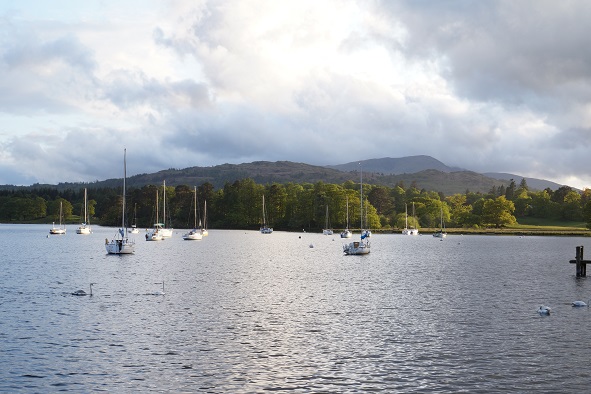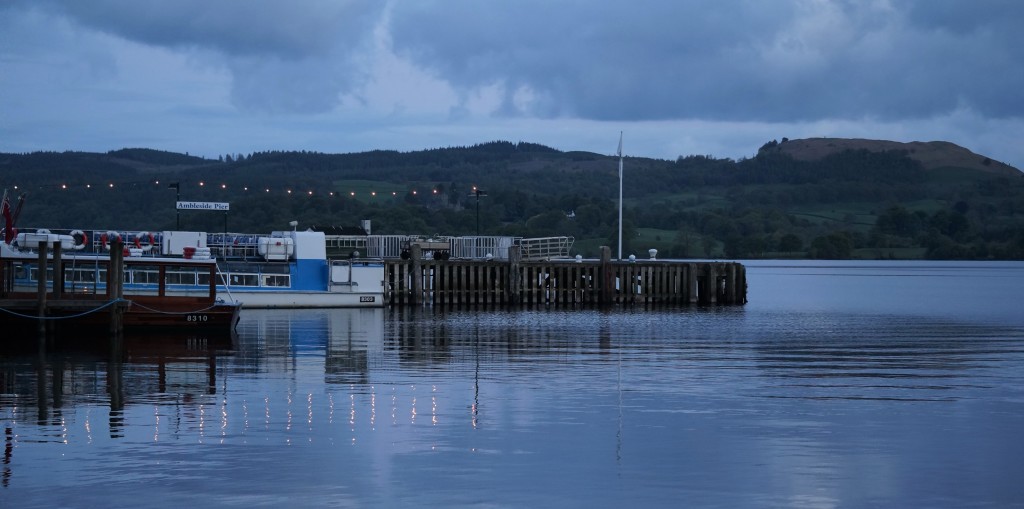While the Lake District prepares for a run at the coveted UNESCO World Heritage Site badge, one of its towns, Ambleside, continues to enchant visitors with the magic of this famous National Park. As well as a selection of cosy pubs, a spectacular waterfall and diverse dining options, Ambleside is the primary base for walkers and cyclists heading into the iconic surrounding hills.

Photo: Simon Willis
Located almost in the centre of the Lake District, Cumbria, and at the tip of Lake Windermere, Ambleside bursts with charm and beauty.
To the south of the town, winding down the hill, curve the banks of England’s largest, and possibly most famous, natural lake. Here, a few excellent hotels like the Waterhead and The Regent overlook the tranquil waters. During the summer, expect to see white sailing boats gently swaying on the navy blue surface, swans bobbing along, occasionally dunking their heads under, and hills shaded in various greens skirting the shore. If it weren’t for the smell of vinegar swirling from the fish and chip shops it could be mistaken for Switzerland’s Lake Geneva.
Few cars enter the town so the walk there is relaxing. The White Platts Recreation Ground throbs with young children swinging putters on the crazy golf course and strolling couples licking ice creams. At the far end, lawn bowling balls slowly roll along the pristine green, elderly competitors waiting to see how close stop to the white jack.
While much of Ambleside’s charm lies in its traditions: Its cosy pubs, wool trade roots and slate and grey stone buildings, walking up the street from the Recreation Ground’s old black and white pavilion whips you to other parts of the world. Thai, Chinese and Indian restaurants blow out sweet gland-watering smells to entice people through the colourful doors.
The old cinema, Zeffirellis, serves up pizzas and pastries while its sister operation, Fellinis, revels in its self-proclaimed ‘vegeterranean’ tag thanks to its Mediterranean/vegetarian menu. But for a more traditional fare, Sheila’s Cottage is the best. This tiny restaurant, surreptitiously situated down a side street behind Tesco, serves tasty pan fried fish and exquisite crème brûlée (among other dishes) in a homely setting.
International Recognition
In 2017, the Lake District will discover if it will become the UK’s first National Park on UNESCO’s list of World Heritage Sites. Those running the National Park hope that the recognition can help preserve the site as well as give tourism a boost as it has done with some, but by no means all, destinations.
John Hodgson, Senior Archaeology and Heritage Adviser at the National Park, warns that simply being on the list is no guarantee of higher tourism numbers or further government funding.
“We are not entirely sure what would change in terms of tourism. It’s more a case of what we could do with the inscription,” he said.
“If we sit back and do nothing it’ll be a waste. We would need to push the UNESCO badge and make sure we attract more cultural tourists who stay for longer and spend more.”
According to research carried out by the National Park, a 1 per cent shift towards these types of tourists, many of whom pen Heritage Sites on their bucket lists, could bring in an extra £20million a year to the region, a huge boost considering public sector cutbacks in the UK.
Part of the Lake District’s bid focuses on its extraordinary landscape; another on various greats of romantic poetry and literature.

Late Evening on Lake Windermere’ (Photo: Simon WIllis)
The park’s opulent beauty has inspired such poets as William Wordsworth, Samuel Coleridge and John Ruskin. And the work of Beatrix Potter was also heavily influenced by the surrounding landscapes and wildlife. Indeed, the famed author will be forever woven in the fabric of the area. The house where she wrote many of her books is a popular tourist attraction while children become captivated with the world of Peter Rabbit, Mrs Tiggy-Winkle and co at The World of Beatrix Potter Attraction, located a few miles down the road in Bowness-on-Windermere.
Hikers Paradise
Ambleside provides the perfect starting point for walkers, cyclists and climbers wanting to explore the surrounding hills. It’s difficult to walk a few meters in the town without finding a climbing or outdoorsy shop selling the latest adventure equipment. It’s equally difficult to miss the thick-calved hikers stomping through the town, or Lycra-laden bikers filling up with nutritional fuel before they tackle one of the many trails leading from the town and into the hills.
As well as the plethora of marked tracks, a mini adventure can be found right here in Ambleside.
Head opposite the Harris Tweed shop selling suit jackets, waistcoats and of course the famous flat caps, and down past a rotating red and white barber’s tube sitting on a dry stone wall to a tree-laden orchard.
On one side of the gravelly trail, the sound of the gushing river filters through the fluttering lime green tree leaves. At the other side, thick dark moss wraps over the stone walls with a smattering of long-stemmed bluebells protruding from above. Wild garlic stings the nostrils along the way. A few smaller waterfalls lead up the left before you reach the Stock Ghyll Force, a 70-foot waterfall bursting through the rocks.

One of a few small waterfalls leading to the Stock Ghyll Force (Photo: Simon Willis)
In the evening, especially on a summer weekend, workers and hikers gather at local pubs seeking an end-of-the-day reward. The White Lion Hotel, located in the centre of the town, serves hearty food and a wide selection of tap beers. Expect bulky men in t-shirts and shorts to be downing pints of lager and munching crisps while the sunlight disappears across the pub’s white front.
If you get chance, take an evening stroll out of town and towards the lake. You will be rewarded with hills, boats, swans, ducks and the brightly lit hotels reflecting a perfectly symmetrical scene onto the sultry waters.
Only time will tell if UNESCO accept the Lake District onto its list of World Heritage Sites, and what the possible benefits would be. For now, though, this famous National Park, and traditional towns like Ambleside, continue to flourish as a tourism hot-spot for the people of Britain.